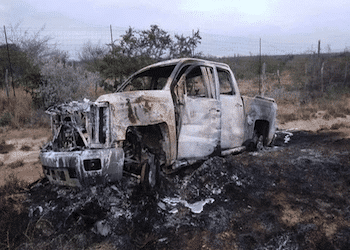Nineteen people shot and burned in a Mexico border state near Texas is a macabre reminder that migrants being smuggled to the United States are targets of cartel violence.
The victims — later identified as Guatemalan nationals — were discovered in Tamaulipas, a border state commonly transited by migrants. The state is also home to the Gulf Cartel and Northeast Cartel, a splinter group of the once-powerful Zetas.
Authorities discovered the gruesome scene after receiving a report on January 22 of a vehicle on fire in the municipality of Camargo. A second burnt vehicle was found with it. Bodies were found in the cabin and piled up in the truck’s bed, Mexico security officials said in a news release. Before being burned, the victims had been shot.
Trump Leaves Biden Corruption Problem at Mexico Border Wall
Because no bullet casings were found at the scene, authorities believe that the victims were killed elsewhere and then moved.
Although the bodies have not been officially confirmed as the 19 migrants traveling from Guatemala, family members said the coyote in charge of the trip had confirmed it was them. Some of the family members are reportedly submitting to DNA tests for confirmation.
The incident has drawn comparisons to previous mass killings, which have become common in the Tamaulipas region over the last decade. The most notable was the 2010 San Fernando Massacre, in which 72 people, many of them Central and South American migrants, were shot in the head and left in a warehouse owned by the Zetas Cartel. A year later, there was a “second” San Fernando Massacre involving 193 people who were pulled from buses, killed and buried in mass graves.
Since then, several other mass killings have occurred in the state, including 21 cartel members who in 2019 were shot and burned in the municipality of Miguel Alemán.
President Andrés Manuel López Obrador has pledged to drastically reduce this kind of violence in the country, including devoting “unlimited resources” to uncovering mass graves.
“This is not San Fernando,” Interior Secretary Olga Sánchez Cordero said about the 19 murdered migrants, “because we are advancing a forceful investigation. There will be no impunity.”
InSight Crime Analysis
Though there remains much uncertainty as to why the migrants were killed, they were clearly on a dangerous path controlled by Mexico’s powerful crime groups.
Coyotes generally have to pay the cartels to travel through their territory, and unpaid debts have sparked many previous mass killings in Tamaulipas. But in this case, it seems strange that the coyote was able to walk free and even alert the families in Guatemala that their relatives had been killed.
The coyote may have been working in tandem with one of the cartels, turning over the migrants for forced labor duties, and killing them when they refused. Migrants are an easy target for these kinds of human trafficking operations because they have no family in Mexico, little familiarity with the area, and will rarely go to the authorities to report a crime.
Migrants at Risk as Coronavirus Shutters Mexico Shelters
Cartels can also use migrants to even debts with rivals, and have been known to leave bodies in public spaces as a show of strength. A local human rights defender in Tamaulipas, who spoke to InSight Crime on the condition of anonymity out of safety concerns, said it is also worth considering that the police may have been involved in the incident.
While the claim remains unsubstantiated, there is plenty of precedent in Mexico to suggest it is possible. During the second San Fernando Massacre, for example, it was discovered that police assisted with lookout duties and the kidnapping of some victims.
Law enforcement crackdowns on migrants moving through Mexico could be also be contributing to the violence.
Instead of focusing patrols only at border crossings, the López Obrador government has set up additional checkpoints and sent troops to the interior of the country, where migrants are known to travel by bus or in caravans. This creates “choke points” where authorities are waiting to make arrests, forcing migrants to look for new routes.
“It is a conundrum that the current administration finds itself in,” said Ariel Ruiz of the Migration Policy Institute. “The López Obrador administration seeks to prioritize migrants’ human rights in implementing its agenda, but its deployment of the national guard in migration control operations has changed migrants’ decision-making, resulting in riskier routes and conditions.”
Mass killings in Tamaulipas will likely continue to occur as long as law enforcement and officials continue to fail, or neglect, to prosecute the people responsible. Rarely do mass killings lead to arrests, let alone sentencing. And obtaining information from the government can take years, according to Ana Lorena Delgadillo, director of the Mexico-based Foundation for Justice and the Democratic Rule of Law.
“There is no real strategy to investigate and dismantle these criminal networks,” Delgadillo told InSight Crime.

